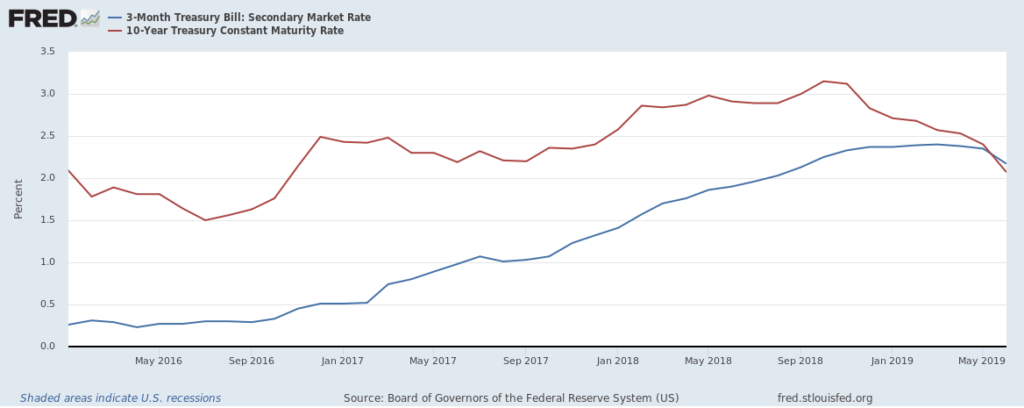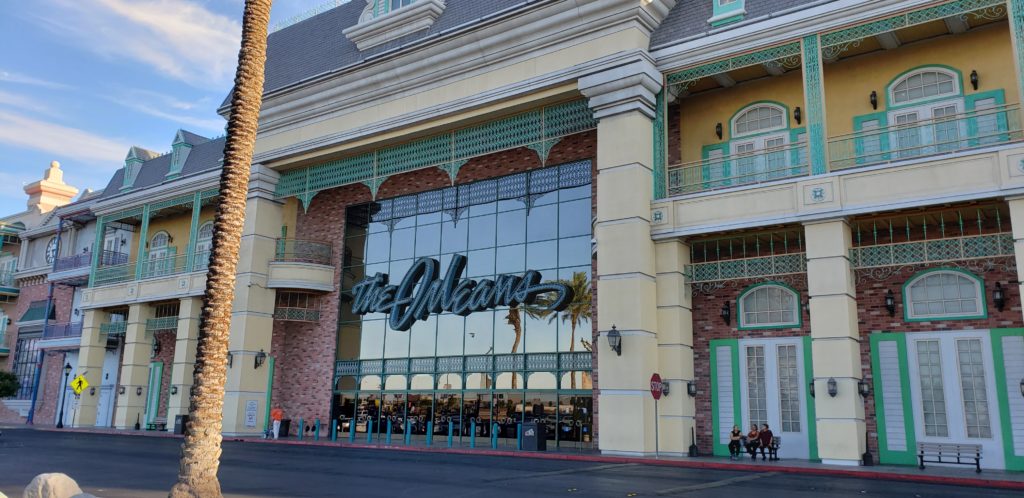Risk-On, Risk-Off
The highly volatile market environment that has been with us for quite some time is characteristic of a phenomenon known as “risk-on, risk-off.” The risk-on, risk-off phenomenon is a market environment where investors flock to safe investments (risk-off) when they are worried about economic and market conditions; and conversely, run to riskier assets (risk-on) when they are optimistic about the investment climate. In reality, any given market environment exhibits this phenomenon as the market rises and falls; but this term is usually reserved for the highly volatile markets that we have been experiencing lately. In markets such as these, investors often switch back and forth between less risk and more risk on a daily basis.
Economic and Investment Highlights
Last Week
Bond yields across the globe have been falling amid concerns of a slowing economy. The 10-year U.S. Treasury fell below 2% the week before last, the first time since 2016, and ended last week at 2%. Currently, the yield curve has inverted with the 10-year Treasury yield below the 3-month Treasury Bill rate (see chart below in Charts for Review and Thought).
U.S. crude oil exports are surging as tensions rise in the Persian Gulf. OPEC officials said they expect to extend their oil production cuts into the second half of the year.
Markets have been exhibiting a “risk-on, risk-off” phenomenon where markets split into two broad categories that move together.
Fed Chairman Powell said the Fed is carefully monitoring the financial markets, the economy, and other factors to determine when the next interest rate move up or down may be warranted. Powell said the amount of tariffs against China and other countries is not currently large enough to pose a threat to the economy; but the Fed is watching for signs of “a loss of confidence or financial market reaction.”
The Conference Board’s index of consumer confidence fell to 121.5 in June from 131.3 in May. This was the lowest level since September 2017 and was attributed to trade tensions and a cooling jobs market.
As indicated by short positions on Bitcoin futures, hedge funds and large traders are betting heavily against Bitcoin. Small investors have largely taken the other side of the trade showing their optimism for the blockchain currency. Bitcoin had traded above $11,000 recently.
Gross Domestic Product (GDP) grew at a strong 3.1% pace in the first quarter of 2019. Consumer spending grew 0.9% in the first quarter, but that was a slower pace than the 2.5% pace in the fourth quarter of last year. Business investment, exports, and government spending all grew at a faster pace. These results reinforce our view that the economy is in a stable but vulnerable state. The Fed recently referred to this situation as “uncertainties” in the economic outlook.
The S&P 500 rose 3.8% in the second quarter; and has risen 17% so far this year. The Dow Jones Industrial Average, the S&P 500 and the Nasdaq all fell slightly for the week, 0.4% for the Dow, 0.29% for the S&P 500 and 0.3% for the Nasdaq. The 10-year treasury yield closed out the quarter at 2%.
The Week Ahead
This link takes you to Econoday’s Economic Calendar and Economic Events and Analysis which shows the upcoming economic reporting events scheduled in the week and months ahead.
Summary
Note: The comments that follow are derived from the economic indicators referenced in the Resources section of this newsletter and other sources in this report.
The Aruoba-Diebold-Scotti Business Conditions Index (ALS) has been trending up the last several weeks and is now very close to the zero line. The ALS Index advanced slightly again this past week. This is a very positive indicator for the economy on a short-term basis.
The GDPNow model estimate for real GDP growth (seasonally adjusted annual rate) in the second quarter of 2019 is 1.5 percent on July 1, unchanged from 1.5% on June 28. This slight adjustment continues to support the ALS model assessment of an improving short-term economic environment.
The New York Fed Staff Nowcast stands at 1.3% for 2019:Q2 and 1.2% for 2019:Q3.
The Chicago Fed National Activity Index (CFNAI) showed an increase in economic activity in May. The Chicago Fed National Activity Index (CFNAI) was –0.05 in May, up from –0.48 in April.
All told, these short-term economic indicators are a neutral to positive analysis for the economy, at least on a short-term basis.
Expectations that stock prices will rise over the next six months rose this past week and is now at 29.6%, an unusually low level, in the latest AAII Sentiment Survey. The historical average is 38.5% for the survey. Please see the AAII Sentiment Survey for the complete results.
The latest Gross output (GO) reading suggests slow economic growth as we enter 2019.
On a longer-term basis, the forecasters in the Philadelphia Fed’s Survey of Professional Forecasters (as of May 10, 2019) predict real GDP will grow at an annual rate of 1.9 percent this quarter and 2.1 percent next quarter. On an annual-average over annual-average basis, the forecasters predict real GDP to grow 2.6 percent in 2019, 2.0 percent in 2020, 1.9 percent in 2021 and 2.3 percent in 2022. The forecasters predict the unemployment rate will average 3.7 percent in 2019, 3.6 percent in 2020, 3.7 percent in 2021, and 3.9 percent in 2022.
For a more in-depth review and analysis of the economy, please see our mini-book on economic analysis and forecasting entitled: Simple and Effective Economic Forecasting.
Stock Market Valuations
Our estimates of the market valuations for two stock market indices, the Dow Jones Industrial Average (DJIA) and the Standard & Poor’s 500 (S&P 500), can be found in the file below:
Conclusion
We continue to believe the economy is in a stable but now more vulnerable state. Recent economic reports have been showing signs of weakening. Nonetheless, the economy has remained fairly strong. In fact, the extremely strong first quarter GDP showing and the strong labor market conditions still give us confidence that the economy, now in its tenth year of expansion, can continue to grow. But we are cautious on this outlook! Please see our complete Economic and Investment Review in the Winter 2019 quarterly issue of the Intrinsic Value Wealth Report Newsletter.
The broad market remains overvalued, although the Dow Jones Industrial Average looks more fairly valued than the broad market. But that does not mean that a market correction is imminent. Markets can and do stay overvalued for long periods of time. As discussed above and in the Economic and Investment Highlights section of this Commentary, we believe the economy is in a stable but vulnerable state that is showing signs of weakening. If the economy remains strong, the markets will likely remain strong. If the economy deteriorates, the markets may well correct. There are other events that could trigger a market correction, of course, but economic conditions are the most likely and foreseeable events that could make that happen.
We believe it is important to maintain a long-term view toward investing. This means that you should continue building your investment portfolio using the Cassandra Stock Selection Model to select individual securities that offer growth and value opportunities.
Chart for Review and Thought

Announcements
We have been researching the use of crowdsourcing for investment ideas. We will be sending a survey out in the next few weeks to get your input on the economy and the markets; and to get any investment ideas that you would like to share. We will compile this input and distribute the results to you and our other subscribers.
Dr. Wendee will be speaking at FreedomFest during its annual conference in Las Vegas, July 17 – 20, 2019.
Business 539 – Financial Management – On July 1, 2019, Dr. Wendee started teaching Business 539 – Financial Management at California Baptist University (CBU). Dr. Wendee teaches courses in Finance and Economics at CBU.
Management 3080 – Business Responsibility in Society – Dr. Wendee will be teaching Management 3080 – Business Responsibility in Society at California State University, Los Angeles (CSULA) starting August 22, 2019. Dr. Wendee teaches courses in Management at CSULA.
Business 217 – Microeconomics – Dr. Wendee will be teaching Business 217 – Microeconomics at California Baptist University (CBU) starting September 4, 2019. Dr. Wendee teaches courses in Finance and Economics at CBU.
Business 218 – Macroeconomics – Dr. Wendee will be teaching Business 218 – Macroeconomics at California Baptist University (CBU) starting September 4, 2019. Dr. Wendee teaches courses in Finance and Economics at CBU.
Dr. Wendee will be presenting a paper on enterprise value creation at the International Leadership Association’s annual global conference which is being held in Ottawa, Canada this Fall.
Dr. Wendee spoke at the Investment Club of America (formerly the Las Vegas Investment Club) on June 24th at the Orleans Hotel in Las Vegas. He spoke on the topic of his popular Forbes article, Nine of the Best Ways to Build Wealth.

Intrinsic Value Wealth Creation pyramid
We always conclude our commentary with a discussion of the Intrinsic Value Wealth Creation Pyramid. The Intrinsic Value Wealth Creation Pyramid is designed to show some of the major categories for building wealth. It is the result of many years of study of the wealth building process; experience working with clients who have built considerable wealth; and my own personal experience building wealth. Newsletter subscribers should consult the Intrinsic Value Wealth Creation Pyramid as one of many useful investment tools while considering their investment plans.
The chart in this section is an expanded version of the Intrinsic Value Wealth Creation Pyramid Chart referenced in the Forbes.com article entitled, Nine Of The Best Ways To Build Wealth.
RESOURCES
See our Resources section for links to economic and other resources used in the preparation of this Commentary.
